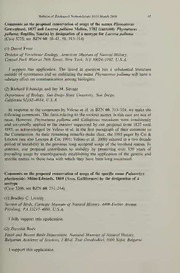
Comments On The Proposed Conservation Of Usage Of The Specific Name Palaeortyx Phasianoides Milne edwards, 1869 (Aves, Galliformes) By The Designation Of A Neotype. Case 3266 PDF
Preview Comments On The Proposed Conservation Of Usage Of The Specific Name Palaeortyx Phasianoides Milne edwards, 1869 (Aves, Galliformes) By The Designation Of A Neotype. Case 3266
Bulletin ofZoological Nomenclature 61(1) March 2004 47 Comments on the proposed conservation of usage of the names Phymaturus Gravenhorst, 1837 and Lacertapalluma Molina, 1782 (currently Phymaturus palluma', Reptilia, Sauria) by designation of a neotype for Lacertapalluma (Case 3225; see BZN 60: 38-41, 58, 313-314) (1) Darrel Frost Division of Vertebrate Zoology, American Museum ofNatural History, Central Park West at 79th Street, New York, NY 10024-5192, U.S.A. I support this application. The lizard in question has a substantial literature outside of systematics and so stabilizing the name Phymaturuspalluma will have a salutary effect on communication among biologists. (2) Richard Etheridge and Jay M. Savage Department ofBiology, San Diego State University, San Diego, California 92182-4614, U.S.A. In response to the comments by Veloso et al. in BZN 60: 313-314, we make the following comments. The facts relating to the various names in this case are not at issue. However, Phymaturus palluma and Callopistes maculatus were consistently and universally applied in the manner supported by our proposal from 1837 until 1985, as acknowledged by Veloso et al. in the first paragraph of their comment to the Commission. As their remaining remarks make clear, the 1985 paper by Cei & Lescure (see also Lescure & Cei, 1991; Veloso et al., 2000) ushered in a two decade period of instability in the previous long accepted usage of the involved names. In contrast, our proposal contributes to stability by preserving over 150 years of prevailing usage by unambiguously establishing the application of the generic and specific names to those taxa with which they have been long associated. Comments on the proposed conservation of usage of the specific name Palaeortyx phasianoid.es Milne-Edwards, 1869 (Aves, Galliformes) by the designation of a neotype (Case 3266; see BZN 60: 211-214) (1) Bradley C. Livezey Section ofBirds, Carnegie Museum ofNatural History, 4400 Forbes Avenue, Pittsburg, PA 15213-4080, U.S.A. I fully support this application. (2) Zlatozar Boev Fossil and Recent Birds Department, National Museum ofNatural History, Bulgarian Academy ofSciences, 1 Blvd. Tsar Osvoboditel, 1000 Sofia, Bulgaria I support this application.
